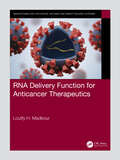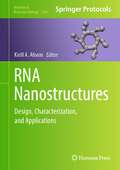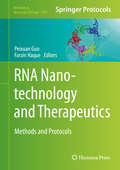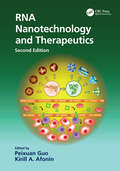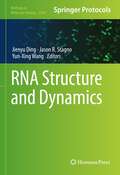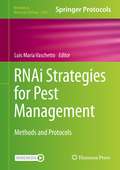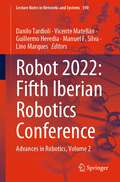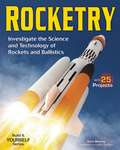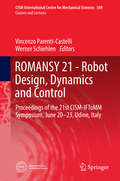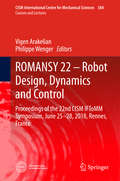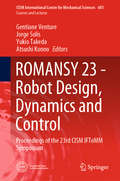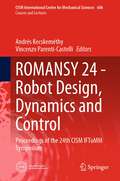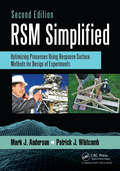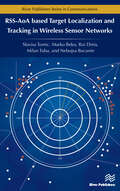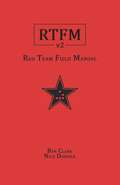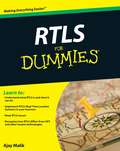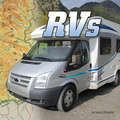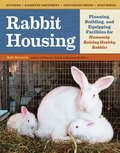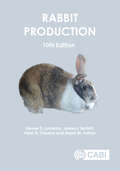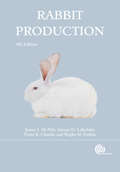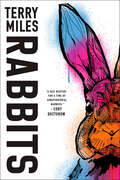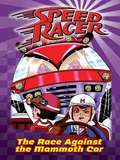- Table View
- List View
RNA Delivery Function for Anticancer Therapeutics (Nanotechnology for Drugs, Vaccines and Smart Delivery Systems)
by Loutfy H. MadkourThis book presents an overview of the current status of translating the RNAi cancer therapeutics in the clinic, a brief description of the biological barriers in drug delivery, and the roles of imaging in aspects of administration route, systemic circulation, and cellular barriers for the clinical translation of RNAi cancer therapeutics, and with partial content for discussing the safety concerns. It then focuses on imaging-guided delivery of RNAi therapeutics in preclinical development, including the basic principles of different imaging modalities, and their advantages and limitations for biological imaging. With growing number of RNAi therapeutics entering the clinic, various imaging methods will play an important role in facilitating the translation of RNAi cancer therapeutics from bench to bedside. RNAi technique has become a powerful tool for basic research to selectively knock down gene expression in vitro and in vivo. Our scientific and industrial communities have started to develop RNAi therapeutics as the next class of drugs for treating a variety of genetic disorders, such as cancer and other diseases that are particularly hard to address with current treatment strategies. Key Features Provides insight into the current advances and hurdles of RNAi therapeutics. Accelerates RNAi, miRNAs, and siRNA drug development for cancer therapy from bench to bedside. Addresses various modifications and novel delivery strategies for miRNAs, piRNAs and siRNA delivery in anticancer therapeutics. Explores the need for the interaction of hematologists,cell biologists, immunologists, and material scientists in the development of novel cancer therapies. Describes the current status of clinical trials related to miRNA and siRNA-based cancer therapy Presents remaining issues that need to be overcome to establish successful therapies.
RNA Nanostructures: Design, Characterization, and Applications (Methods in Molecular Biology #2709)
by Kirill A. AfoninThis volume details protocols for computer-assisted design and experimental characterization of RNA nanostructures. Chapters guide readers through RNA nanotechnology, design and characterization of RNA nanostructures, assessment of immunology of nanomaterials, biosensing and drug delivery, various biomedical applications, and delivery approaches for therapeutic RNA nanoparticles. Written in the format of the highly successful Methods in Molecular Biology series, each chapter includes an introduction to the topic, lists necessary materials and reagents, includes tips on troubleshooting and known pitfalls, and step-by-step, readily reproducible protocols. Authoritative and cutting-edge, RNA Nanostructures: Design, Characterization, and Applications aims to address essential topics and concerns in the growing field of RNA nanotechnology.
RNA Nanotechnology and Therapeutics
by Peixuan Guo Farzin HaqueInterest in RNA nanotechnology has increased in recent years as recognition of its potential for applications in nanomedicine has grown. Edited by the world's foremost experts in nanomedicine, this comprehensive, state-of-the-art reference details the latest research developments and challenges in the biophysical and single molecule approaches in RNA nanotechnology. In addition, the text also provides in-depth discussions of RNA structure for nanoparticle construction, RNA computation and modeling, single molecule imaging of RNA, RNA nanoparticle assembly, RNA nanoparticles in therapeutics, RNA chemistry for nanoparticle synthesis, and conjugation and labeling.
RNA Nanotechnology and Therapeutics
by Peixuan Guo Kirill A. AfoninInterest in RNA nanotechnology has increased in recent years as recognition of its potential for applications in nanomedicine has grown. Edited by the world's foremost experts in nanomedicine, this comprehensive, state-of-the-art reference details the latest research developments and challenges in the biophysical and single molecule approaches in RNA nanotechnology. In addition, the text also provides in-depth discussions of RNA structure for nanoparticle construction, RNA computation and modeling, single molecule imaging of RNA, RNA nanoparticle assembly, RNA nanoparticles in therapeutics, immunorecognition of RNA nanomaterials, RNA chemistry for nanoparticle synthesis, and conjugation and labeling. Presents the latest research and discoveries in RNA nanotechnology Features contributions from world-class experts in the field Covers RNA nanoparticles in therapeutics Describes self-assembled RNA nanoparticles
RNA Structure and Dynamics (Methods in Molecular Biology #2568)
by Jienyu Ding Jason R. Stagno Yun-Xing WangThis volume provides a wide spectrum of multidisciplinary approaches for studying RNA structure and dynamics, including detailed accounts of experimental and computational procedures. Chapters guide readers through cryo-electron microscopy, crystallography, isothermal titration calorimetry, small angle X-ray scattering, single-molecule Förster Energy transfer, X-ray free electron laser, atomic force microscopy, computational simulation, and prediction. Written in the format of the highly successful Methods in Molecular Biology series, each chapter includes an introduction to the topic, lists necessary materials and reagents, includes tips on troubleshooting and known pitfalls, and step-by-step, readily reproducible protocols.Authoritative and cutting-edge, RNA Structure and Dynamics aims to be a foundation for future studies and to be a source of inspiration for new investigations in the field.
RNAi Strategies for Pest Management: Methods and Protocols (Methods in Molecular Biology #2360)
by Luis María VaschettoThis volume explores the latest techniques used for sustainable development of eco-friendly pest management systems. Chapters in this book look at the design of novel RNAi-mediated pest control strategies and related issues. Some of the topics covered in this book are identification and characterization of differentially expressed non-coding RNAs in insect genomes; functional small RNA design; analysis of endogenous RNAi pathways; RNAi screening; plant models of RNAi-mediated pest control; and dsRNA delivery. Written in the highly successful Methods in Molecular Biology series format, chapters include introductions to their respective topics, lists of the necessary materials and reagents, step-by-step, readily reproducible laboratory protocols, and tips on troubleshooting and avoiding known pitfalls. Cutting-edge and comprehensive, RNAi Strategies for Pest Management: Methods and Protocols is a valuable resource for any scientist or researcher interested in learning more about this exciting and developing field. Chapter 18 is available open access under a Creative Commons Attribution 4.0 International License via link.springer.com.
ROBOT2022: Advances in Robotics, Volume 2 (Lecture Notes in Networks and Systems #590)
by Manuel F. Silva Danilo Tardioli Vicente Matellán Guillermo Heredia Lino MarquesThis book contains a selection of papers accepted for presentation and discussion at ROBOT 2022—Fifth Iberian Robotics Conference, held in Zaragoza, Spain, on November 23-25, 2022. ROBOT 2022 is part of a series of conferences that are a joint organization of SEIDROB—Sociedad Española para la Investigación y Desarrollo en Robótica/Spanish Society for Research and Development in Robotics, and SPR—Sociedade Portuguesa de Robótica/Portuguese Society for Robotic. ROBOT 2022 builds upon several previous successful events, including three biennial workshops and the four previous editions of the Iberian Robotics Conference, and is focused on presenting the research and development of new applications, on the field of Robotics, in the Iberian Peninsula, although open to research and delegates from other countries. ROBOT 2022 featured four plenary talks on state-of-the-art subjects on robotics and 15 special sessions, plus a main/general robotics track. In total, after a careful review process, 98 high-quality papers were selected for publication, with a total of 219 unique authors, from 22 countries.
ROCKETRY
by Carla Mooney Caitlin DenhamDo you ever wonder how rockets soar into space? Rocketry: Investigate the Science and Technology of Rockets and Ballistics introduces students to the fascinating world of rocketry and ballistics. Readers discover the history of rocket development, from the earliest fire arrows in China to modern-day space shuttles, as well as the main concepts of rocketry, including how rockets are launched, move through the atmosphere, and return to earth safely. Exploring the science behind rocket flight, kids learn how the forces of thrust, gravity, lift, and drag interact to determine a rocket's path, then imagine new uses and technologies in rocketry that are being developed today and for the future.Combining hands-on activities with physics, chemistry, and mathematics, Rocketry brings fun to learning about the world of rocket science. Entertaining illustrations and fascinating sidebars illuminate the topic and bring it to life, while Words to Know highlighted and defined within the text reinforce new vocabulary.Projects include building a pneumatic blast rocket and launcher, determining the role of fins in rocket stability, testing a rocket recovery system, and designing a rocket model of the future. Additional materials include a glossary, and a list of current reference works, websites, and Internet resources.
ROMANSY 21 - Robot Design, Dynamics and Control
by Werner Schiehlen Vincenzo Parenti-CastelliThis proceedings volume contains papers that have been selected after review for oral presentation at ROMANSY 2016, the 21th CISM-IFToMM Symposium on Theory and Practice of Robots and Manipulators. These papers cover advances on several aspects of the wide field of Robotics as concerning Theory and Practice of Robots and Manipulators. ROMANSY 2016 is the 21st event in a series that started in 1973 as one of the first conference activities in the world on Robotics. The first event was held at CISM (International Centre for Mechanical Science) in Udine, Italy on 5-8 September 1973. It was also the first topic conference of IFToMM (International Federation for the Promotion of Mechanism and Machine Science) and it was directed not only to the IFToMM community.
ROMANSY 22 – Robot Design, Dynamics and Control: Proceedings Of The 22nd Cism Iftomm Symposium, June 25-28, 2018, Rennes, France (CISM International Centre for Mechanical Sciences #584)
by Philippe Wenger Vigen ArakelianThis proceedings volume contains papers that have been selected after review for oral presentation at ROMANSY 2018, the 22nd CISM-IFToMM Symposium on Theory and Practice of Robots and Manipulators. These papers cover advances on several aspects of the wide field of Robotics as concerning Theory and Practice of Robots and Manipulators.ROMANSY 2018 is the 22nd event in a series that started in 1973 as one of the first conference activities in the world on Robotics. The first event was held at CISM (International Centre for Mechanical Science) in Udine, Italy on 5-8 September 1973. It was also the first topic conference of IFToMM (International Federation for the Promotion of Mechanism and Machine Science) and it was directed not only to the IFToMM community.
ROMANSY 23 - Robot Design, Dynamics and Control: Proceedings of the 23rd CISM IFToMM Symposium (CISM International Centre for Mechanical Sciences #601)
by Gentiane Venture Yukio Takeda Jorge Solis Atsushi KonnoThis book highlights the latest innovations and applications in robotics, as presented by leading international researchers and engineers at the ROMANSY 2020, the 23rd CISM IFToMM Symposium on Theory and Practice of Robots and Manipulators. The ROMANSY symposium is the first established conference that focuses on robotics theory and research, rather than industrial aspects. Bringing together researchers from a broad range of countries, the symposium is held bi-annually and plays a vital role in the development of the theory and practice of robotics, as well as the mechanical sciences. ROMANSY 2020 marks the 23rd installment in a series that began in 1973. The event was also the first topic-specific conference of the IFToMM, though not exclusively intended for the IFToMM community.
ROMANSY 24 - Robot Design, Dynamics and Control: Proceedings of the 24th CISM IFToMM Symposium (CISM International Centre for Mechanical Sciences #606)
by Andrés Kecskeméthy Vincenzo Parenti-CastelliThis book highlights the latest innovations and applications in robotics, as presented by leading international researchers and engineers at the ROMANSY 2022, the 24th CISM IFToMM Symposium on Theory and Practice of Robots and Manipulators, held in Udine, Italy, on July 4–7, 2022. The ROMANSY symposium is the first established conference that focuses on robotics theory and research, rather than industrial aspects. Bringing together researchers from a broad range of countries, the symposium is held bi-annually and plays a vital role in the development of the theory and practice of robotics, as well as the mechanical sciences. ROMANSY 2022 marks the 24th instalment in a series that began in 1973.
RSM Simplified: Optimizing Processes Using Response Surface Methods for Design of Experiments, Second Edition
by Mark J. Anderson Patrick J. WhitcombAnderson and Whitcomb pick up where they left off in DOE Simplified with RSM Simplified -- a practical tool for design of experiments that anyone with a minimum of technical training can understand and appreciate. Their approach is simple and fun for those who desire knowledge on response surface methods but are put off by the academic nature of other books on the topic. RSM Simplified keeps formulas to a minimum and makes liberal use of figures, charts, graphs, and checklists. It offers many relevant examples with amusing sidebars and do-it-yourself exercises that will lead readers to the peak potential for their product quality and process efficiency.
RSS-AoA-based Target Localization and Tracking in Wireless Sensor Networks
by Rui Dinis Slavisa Tomic Marko BekoThe desire for precise knowledge about the location of a moving object at any time instant has motivated a great deal of scientific research recently. This is owing to a steady expansion of the range of enabling devices and technologies, as well as the need for seamless solutions for location-based services. Besides localization accuracy, a common requirement for emerging solutions is that they are cost-abstemious, both in terms of the financial and computational cost. Hence, development of localization strategies from already deployed technologies, e.g., from different terrestrial radio frequency sources is of great practical interest. Amongst other, these include localization strategies based on received signal strength (RSS), time of arrival, angle of arrival (AoA) or a combination of them. RSS-AoA-based Target Localization and Tracking in Wireless Sensor Networks presents recent advances in developing algorithms for target localization and tracking, reflecting the state-of-the-art algorithms and research achievements in target localization and tracking based on hybrid (RSS-AoA) measurements.Technical topics discussed in the book include:Centralized RSS-AoA-based Target LocalizationDistributed RSS-AoA-based Target LocalizationRSS-AoA-based Target Tracking via Maximum A Posteriori EstimatorRSS-AoA-based Target Tracking via Kalman FilterRSS-AoA-based via Sensor NavigationThis book is of interest for personnel in telecommunications and surveillance industries, military, smart systems, as well as academic staff and postgraduate/research students in telecommunications, signal processing, and non-smooth and convex optimization.
RTFM: Red Team Field Manual v2
by Ben Clark Nick DownerOver 8 years ago, the Red Team Field Manual (RTFM) was born out of operator field notes inspired by years of Red Team missions. While tools and techniques change, operators still constantly find themselves in common operating environments, with time running out. The RTFM has provided a quick reference when there is no time to scour the Internet for that perfect command. RTFM version 2 has been completely overhauled, with the addition of over 290 new commands and techniques. It has also been thoroughly updated and tested to ensure it works against modern operating systems. Version 2 includes a new Mac OS section and a section outlining tradecraft considerations. Searching has been streamlined through an expanded table of contents and appendix, and readability has been considerably improved through new text formatting. Finally, RTFM v2 will come in multiple formats including paperback, hardback (coming August 2022), Kindle eBook and an all-new wide margin note taking edition.
RTLS For Dummies
by Ajay MalikSelect, invest in, and deploy a Real Time Location System Is your business ready for an RTLS? This friendly, hands-on guide shows you how to understand and implement this cutting-edge technology, explaining RTLS methodologies in plain English. From the initial deployment to monitoring to determining Return on Investment, you'll see how to successfully meet your needs, ensure data accuracy, and sustain your system. Get your bearings - understand what RTLS does and its various methodologies, determine your needs, and select the right system Prepare for installation - outline your goals, plan your applications, assess your site, select the right tag technology, and conduct a pilot test Implement RTLS in your world - know how to train your staff, set expectations, set up monitoring, and assess whether the RTLS is working as desired Deal with design issues - learn the most common pitfalls of RTLS implementation and how to handle them Take the technology tour - use RTLS to locate at choke points, room level, presence, by association, and precisely Monitor and secure your RTLS - verify and fine-tune your system, establish performance metrics, and manage security issues and vulnerabilities such as network attacks Open the book and find: An overview of RTLS and its uses Explanations of underlying technologies How to integrate RTLS into your other business applications Comparative detail on technologies that enable different types of locating Tips for evaluating RTLS vendors Essential RTLS resources and references Tips for getting the most out of the batteries used in tags Privacy issues related to RTLS
RVs (Wild About Wheels)
by Nancy DickmannIt's time to go camping! With an RV, you will have everything you need! An RV is like a house on wheels. It has beds for sleeping. You can cook in an RV's kitchen. There are comfy places to sit too. Young readers will find out about the types of recreational vehicles, what they have inside, and how they make camping easy!
Rabbit Breeds: The Pocket Guide to 49 Essential Breeds
by Lynn M. StoneRabbits are the third-most popular pet in the United States and have also earned significant farming and commercial followings: fiber enthusiasts love angora for its light-weight warmth, and chefs are serving up increasing amounts of their high-protein, low-fat meat. In Rabbit Breeds, photographer Lynn M. Stone spotlights all 49 breeds recognized by the American Rabbit Breeders Association with adorable original photos, engaging descriptions, and fun facts. This handsome and educational guide is sure to inform and bring a smile to the face of rabbit fanciers and general animal lovers alike.
Rabbit Housing: Planning, Building, and Equipping Facilities for Humanely Raising Healthy Rabbits (Storey's Guide To Raising Ser.)
by Bob BennettCreate a safe, sanitary, and efficient home for your rabbits. In this informative guide, Bob Bennett provides clear step-by-step instructions for building attractive all-wire hutches of all sizes, with additional tips for adding the necessary accessories like feeders, watering systems, nest boxes, and fencing. From the direction a hutch door should swing to proper ventilation and protection from predators, Bennett covers everything you need to know to create a housing structure that will help promote a healthy and productive rabbit-raising operation.
Rabbit Production
by Nephi Patton Peter Robert Cheeke Steven Lukefahr James I McNittRabbits are versatile animals, farmed for their meat and fur, as laboratory animals, and also as pets. This well-established book continues to provide an overview of domesticated rabbit production, covering topics such as breeding, husbandry, feeding and health. Now in its fully updated tenth edition, it includes an expanded consideration of important issues such as animal welfare and sustainable methods of production. With chapters relating specifically to meat production, pet rabbits, rabbit shows, and angora wool production, this new edition: - Includes new information on the latest methods of artificial insemination, estrous synchronization, embryo transfer, cloning and molecular genetics; - Tackles globally prevalent health issues such as enteritis complex (EC) rabbit enterocolitis (REC), and viral hemorrhagic disease; - Reviews up-to-the-minute developments such as the impact of the covid-19 pandemic on food production, as well as new projects addressing poverty alleviation and food security. Providing updates on worldwide production trends, figures and new feed additive products, this book is an essential resource for anyone involved in rabbit production - from novice to experienced breeders, veterinarians and industry professionals.
Rabbit Production
by Nephi Patton Peter Robert Cheeke Steven Lukefahr James McNittThis new edition of Rabbit Production is fully updated throughout. Mainly concerning rabbits bred for meat and fur, it also contains practical information on pet rabbits, show rabbits and rabbits used as laboratory animals. Core topics are covered, including rabbit genetics, reproduction, health and diseases, behaviour, welfare, fur and meat production, rabbit production in developing countries, slaughter and the marketing of rabbit products. Current areas of interest such as animal welfare and coat colour genetics are expanded in the new edition. An important resource for all those involved in rabbit production, this book is also vital reading for students and researchers of animal science and meat production, as well as the keen amateur rabbit enthusiast.
Rabbit Production
by Nephi Patton Peter Robert Cheeke Steven Lukefahr James McnittThis new edition of Rabbit Production is fully updated throughout. Mainly concerning rabbits bred for meat and fur, it also contains practical information on pet rabbits, show rabbits and rabbits used as laboratory animals. Core topics are covered, including rabbit genetics, reproduction, health and diseases, behaviour, welfare, fur and meat production, rabbit production in developing countries, slaughter and the marketing of rabbit products. Current areas of interest such as animal welfare and coat colour genetics are expanded in the new edition. An important resource for all those involved in rabbit production, this book is also vital reading for students and researchers of animal science and meat production, as well as the keen amateur rabbit enthusiast.
Rabbits: A Novel
by Terry MilesA deadly underground game might just be altering reality itself in this all-new adventure set in the world of the hit Rabbits podcast.&“A taut mystery for a time of conspiratorial madness.&”—Cory DoctorowIt&’s an average work day. You&’ve been wrapped up in a task, and you check the clock when you come up for air—4:44 p.m. You check your email, and 44 unread messages have built up. With a shock, you realize the date is April 4—4/4. And when you get in your car to drive home, your odometer reads 44,444.Coincidence? Or have you just seen the edge of a rabbit hole?Rabbits is a mysterious alternate reality game so vast it uses the entire world as its canvas.Since the game started in 1959, ten iterations have appeared and nine winners have been declared. The identities of these winners are unknown.So is their reward, which is whispered to be NSA or CIA recruitment, vast wealth, immortality, or perhaps even the key to the secrets of the universe itself.But the deeper you get, the more dangerous the game becomes. Players have died in the past—and the body count is rising.And now the eleventh round is about to begin.Enter K—a Rabbits obsessive who has been trying to find a way into the game for years. That path opens when K is approached by billionaire Alan Scarpio, rumored to be the winner of the sixth iteration. Scarpio says that something has gone wrong with the game and that K needs to fix it before Eleven starts, or the whole world will pay the price.Five days later, Scarpio is declared missing.Two weeks after that, K blows the deadline: Eleven begins.And suddenly, the fate of the entire universe is at stake.
Race Against the Mammoth Car, The #4
by Chase WheelerSpeed has entered the No Limit World Race, but the competition is overshadowed by the theft of $50 million in gold bars. Can Speed and Racer X solve the crime before they reach the finish line?
Race Car Handling Optimization: Magic Numbers to Better Understand a Race Car
by Ralph Pütz Ton SernéThe reader will first learn to measure his racing car himself in order to ultimately get to know and understand the car's setup better. This is followed successively by the teaching of the basics with the claim of immediate applicability of the knowledge. First, the most important properties of the tyres are described in order to convey how to optimally utilise the properties of the tyres. Only then are the mass-spring system, shock absorbers, anti-roll bars, suspension geometries and aerodynamics dealt with, with the aim of making the best possible use of the tyres' potential. What has been learned is optimally applied to driving through a curve, divided into five essential phases of the corner, and an analysis for possible causes of understeer and oversteer is carried out for each phase, and solutions are given. Finaly examples of laptime simulations are being described, and the book ends with a very clear description of the calculation of the Magic Numbers regarding Roll, Roll Resistance, Load Transfer and Total Wheel Load.
